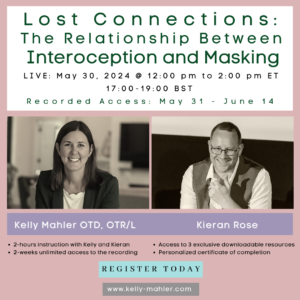
Lost Connections: Interoception & Masking
Hi everyone, Kelly Mahler, occupational therapist. And I want to take the time to talk about something called masking. This is such a big topic, but I want to specifically talk about the connection between interoception and masking.
What is Masking?
In case the word masking is new to you, let’s start out with: what does masking mean? Masking refers to an automatic safety response that occurs when someone projects a certain version of themselves—many times, an inauthentic version of themselves—in order to survive the world.
I am really working to update my understanding in this space. When I first learned about masking quite a few years ago, it was my understanding that it was more of a conscious process, and that many people mask. I thought when masking, we might change our behavior just a little bit in a certain context or situation in order to fit in. But I’ve learned that masking is really so much deeper than that. I’m learning from so many people in this space, including my friend and colleague, Kieran Rose, who is joining me this month for a live course all about interoception and masking.
Masking is Much More Than a Small Change to ‘Fit in’
Masking is a trauma response that occurs in many marginalized communities when a person needs to change the way they are, they need to shift their identity in order to survive stigmatization. This means that many people are masking from very early on in life, and it can extend all the way through adulthood.
For many people, they might be masking for decades. This masking process really creates a breakdown in identity. A person can lose their authentic self, they might lose their sense of who am I?And that also includes dissociation, or the loss of that identity of your felt sense or interoception.
The Connection Between Masking and Interoception
Masking is a trauma response. Many times, it’s happening automatically so someone can survive the world. Part of this is disconnecting from one’s body, from those internal signals. A person may be ignoring what their body needs for comfort, for regulation, for safety, in order to survive the world, in order to meet the needs, demands, or expectations of other people around them. It’s a lifelong process of ignore my body, ignore myself, ignore my boundaries, ignore what my body needs in order to survive the world around me and to survive other people’s expectations. So, this connection between interoception and masking is very tight.
When you spend your whole life being disconnected from your body out of survival, you will likely start to lose your felt sense. You start to lose that understanding of: How does my body really feel in the world? What does my body really need for regulation, for comfort to feel safe in this world?
The Connection Between Unmasking and Interoception
Not only is interoception significantly impacted by masking, but it also plays a key role in the unmasking process. This is the process where someone might be attempting to rediscover, to reconnect to their authentic self. And let’s just say that the unmasking process can be really tricky. It can be a lengthy but worthwhile journey.
Interoception plays a key role in discovering yourself. We use The Interoception Curriculum as a framework for curiosity, for helping each person to discover their own unique set of internal sensations, of helping them to discover their own unique set of actions that their body needs in order to feel safe, in order to thrive in this world. Interoception work is a key process of that inner curiosity of really discovering the anwers to questions like: Who am I? What does my body need in this world to feel safe and to thrive?
That journey can be very fruitful but very difficult. There can be a lot of undoing before making progress in the doing and the moving forward and learning about one’s self. I think this really needs acknowledging. When a person is pursuing self-discovery and self-connection, it shouldn’t only be on them. That responsibility shouldn’t only be on them, in my opinion. It should be on everyone who is surrounding that person, supporting that person, or loving that person. We need to think about how we can work towards providing context or spaces or relationships where that person feels safe enough to be their own authentic self, to express their own authentic feels and to be validated and supported in that process.
Until next time.
Want to learn more about masking and interoception? Sign up for our live course!

Information about Part 1, about interoception and monotropism, can also be found here.


